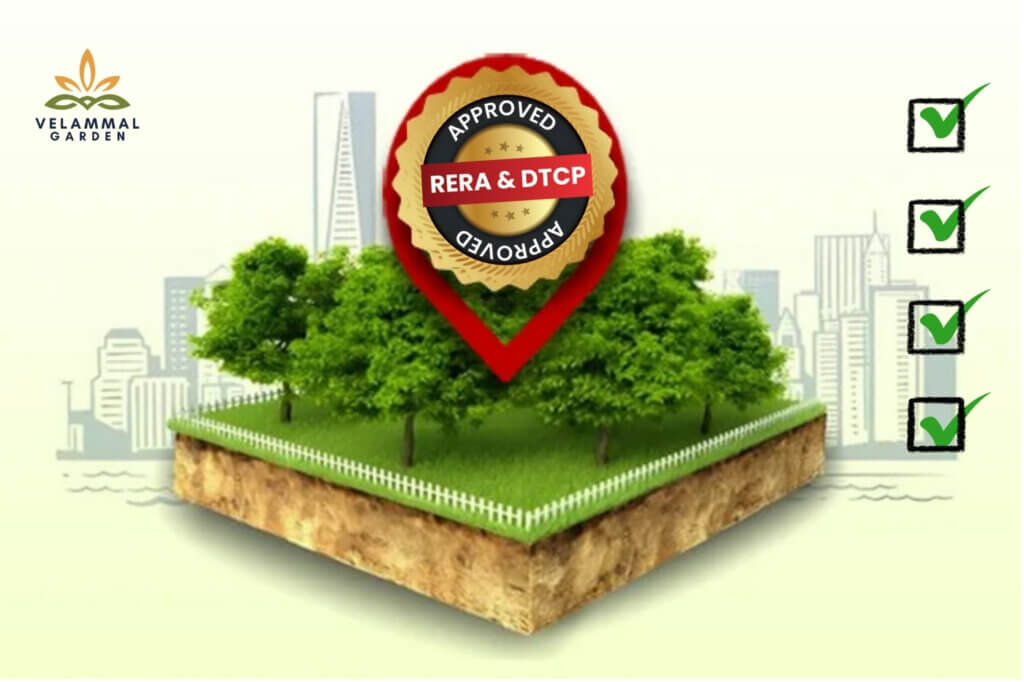Why these checks matter for your home and budget

Before you fall in love with a plot’s price or location, confirm that the ground beneath it is strong, drains well, and sits on a sensible slope. Good soil saves on foundation costs. Proper drainage prevents dampness, pests, and repairs. A gentle slope protects your home during heavy Chennai rains, especially in belts like Padappai and Oragadam.
Quick overview: what to check on day one
- Soil type and bearing strength
- Percolation speed and waterlogging signs
- Natural slope and runoff direction
- Nearby storm drains and road levels
- Monsoon behaviour and neighbour feedback
Soil basics for first-time buyers
Soil around Padappai often ranges from red soil to clayey mixes with lateritic patches. Each behaves differently during rain and under load.
- Red soil
Drains faster, easier to work with, generally stable for standard foundations. - Clayey soil
Retains water, swells when wet and shrinks when dry, needs better drainage planning and sometimes deeper footings. - Loamy mix
Balanced for gardening and manageable for foundations with routine detailing.
Two-minute field tests you can do yourself
- Squeeze test
Take a moist handful of soil and squeeze.- Breaks apart easily: more sandy or red soil, better drainage.
- Stays as a smooth ribbon: more clay content, needs stronger drainage.
- Jar settle test
Fill a transparent bottle with half soil, half water, shake and let it settle. Sand settles first, silt next, clay last. A thick top clay layer means slower drainage.
Bearing capacity and foundations
While formal soil investigation is ideal before construction, you can spot early indicators:
- Consistent red or well-graded soil across corners is a good sign for typical low-rise homes.
- Uneven fill or debris layers suggest you may need soil replacement and compaction.
- If nearby houses used pile foundations, budget for a deeper foundation too.
For a DTCP and RERA approved gated layout like Velammal Garden, primary planning, plot levels, and storm-water flow are curated professionally. Still, do your on-ground checks for peace of mind and accurate budgeting. Learn more at velammalgarden.com.
Drainage: keeping water away from your home
Drainage decides whether your plot stays dry after a one-hour cloudburst.
Simple percolation test
- Dig a pit about 300 mm wide and 450 mm deep.
- Fill with water, let it soak once. Refill and time the drop.
- If water level drops 25–40 mm per hour, percolation is healthy.
- If it barely drops, plan French drains, recharge pits, and raised plinth.
Signs of poor drainage
- Water stains or algae lines on compound walls.
- Persistent wet patches and mosquito larvae in nearby low spots.
- Fine cracks on neighbouring plinths from clay swell-shrink cycles.
Easy drainage upgrades for villas
- Perimeter French drain with perforated pipe and gravel bedding.
- Recharge pit or soakaway to send roof water back to the ground.
- Graded paving so that all surfaces fall away from your walls by at least 1 in 100.
- Kerb and culvert alignment to match the layout’s storm-water direction.
Slope: small levels, big difference
Chennai’s North-East monsoon brings short, heavy bursts. A mild slope helps water move into street drains instead of your porch.
How to eyeball slope in minutes
- Place a marble or a small ball on the plot’s compacted surface. If it rolls consistently in one direction, you have a natural fall.
- Use a 1-metre straightedge with a small spirit level. A fall of 10 mm per metre away from the future house footprint is a good target for yards and driveways.
- Stand after a drizzle and watch where water naturally pools. That is your low point that needs a drain or fill.
Coordinate slope with the street
- Check the finished road level and drain invert level. Your plinth should sit at least 450–600 mm above finished road level in rain-prone lanes.
- Make sure your gate threshold is set so driveway water runs to the street drain and not into your sitout.
Local pointers for Padappai and Oragadam belt
- Expect mixed soils with patches of clay. Plan for recharge pits to improve groundwater and handle quick showers.
- Industrial corridors nearby mean better road networks. Confirm storm-water chambers and regular desilting with the layout team.
- Ask neighbours about last monsoon behaviour. Ten minutes of local talk often reveals the one corner that tends to pond.
Must-ask questions before you book
- What is the natural plot level versus the road crown
- Where is the nearest storm-water intake and what is the fall direction
- Has earth filling been done, and if yes, was it layer-compacted
- Any past waterlogging during peak showers
- Recommended plinth height by the project’s engineer
What Velammal Garden does right
- Planned plot levels with coordinated internal road gradients.
- Provisioned storm-water paths toward outfalls.
- DTCP and RERA approvals for orderly development and better resale confidence.
Book a site walk, carry a simple level, and tick off these checks on ground. Details at velammalgarden.com.
Budgeting tips after your checks
- Keep a contingency of 3 to 5 percent for drainage and soil prep.
- For clay-heavy corners, add gravel sub-base under driveways and a perimeter drain.
- Prioritise a raised plinth and proper roof rainwater downpipes connected to recharge pits.
Quick checklist you can save
- Soil feels gritty not sticky
- Water in test pit drops steadily
- Plot slopes away from house footprint
- Gate level aligns with road and street drain
- No persistent wet patches post-rain
- Neighbours confirm good runoff last monsoon
When to call a professional
- If your jar test shows high clay and your pit stays full for hours.
- If the plot is in a local low pocket compared to adjoining streets.
- If adjacent homes sit on noticeably higher plinths.
A quick geotechnical opinion or site engineer visit will lock your foundation type and drainage details with accuracy.
FAQs
What is the easiest way to check soil quality for a plot in Padappai
Use the squeeze test and a jar settle test on the spot. If the soil forms a long smooth ribbon or the jar shows a thick clay layer at the top, plan better drainage and possibly a raised plinth.
How do I confirm drainage before buying a villa plot
Dig a small pit, fill with water twice, and time the drop. Also, walk the site after a drizzle to see natural flow lines. Ensure that the nearest street drain is at a lower level than your gate.
What slope should I maintain around my future home
Aim for at least 1 in 100 fall away from walls in open areas, and set your plinth 450–600 mm above finished road level in rain-prone stretches to prevent backflow.
Do DTCP and RERA approvals guarantee no waterlogging
Approvals ensure systematic planning and services, but on-plot drainage still depends on correct levels, paved falls, and recharge pits. Do the simple tests and align your plinth to the road.
Why choose Velammal Garden for soil, drainage, and slope confidence
The layout planning, coordinated road gradients, and storm-water pathways reduce surprises during monsoon. You still verify on site, but starting in a curated community makes engineering decisions easier. Explore more at velammalgarden.com.
Final word
Soil, drainage, and slope are simple to check yet powerful in impact. Spend one focused hour on ground with a bottle, a small level, and a shovel. You will negotiate smarter, build safer, and enjoy a dry, long-lasting home in Padappai’s growing corridor. For a guided checklist and site walk, connect with the team at velammalgarden.com.


